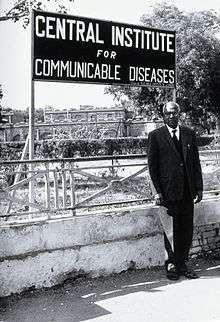National Centre for Disease Control
| Agency overview | |
|---|---|
| Formed | 1909 |
| Preceding agencies |
|
| Superseding agency |
|
| Jurisdiction | India |
| Headquarters | New Delhi |
| Minister responsible | |
| Agency executive |
|
| Parent agency | Ministry of Health and Family Welfare |
| Website | www.nicd.nic.in |
National Centre for Disease Control (NCDC) (previously known as National Institute of Communicable Diseases) is an institute under the Indian Directorate General of Health Services, Ministry of Health and Family Welfare. It was established in July 1963 for research in epidemiology and control of communicable diseases.[1] Currently it has eight branches at Alwar, Bangalore, Trivandrum, Calicut, Coonoor, Jagdalpur, Patna, Rajahmundry and Varanasi to advise the respective state governments on public health.[2]
History

The origin of NICD can be traced back to Central Malaria Bureau, which was established at Kasauli, Himachal Pradesh, India in 1909. It was renamed as the Malaria Institute of India in 1938 and in 1963 renamed as the NICD.[3] On 30 July 2009, it was named as National Centre for Disease Control.[4]
Divisions
NICD has eight divisions under it namely[5]
- Epidemiology division
- Training and malariology division
- Helminthology division
- Biochemistry and Biotechnology division
- Microbiology division
- Medical Entomology and vector control division
- Zoonosis division
- AIDS division
Activities
Doctors from NICD had been previously summoned to investigate potential outbreaks of diseases including suspected cases of Pneumonic plague in Punjab in 2002,[6] SARS oubreaks in 2004,[7] meningitis outbreak in Delhi in 2005,[8] and avian influenza in 2006.[9]
Global Disease Detection (GDD)
The NCDC in collaboration with the Centers for Disease Control and Prevention has set up the Global Disease Detection Regional Center in New Delhi, India.[10] This will lead to long term public health collaboration between the Government of India and the United States in many areas including establishing high quality research and surveillance on important human infectious diseases, establishing the Indian EIS (Epidemiological Intelligence System) program, and developing the NCDC as an international nodal agency in South Asia.
See also
For similar agencies elsewhere, please see list of national public health agencies
References
- ↑ About NICD
- ↑ About NICD branches
- ↑ IN FOCUS:Shaping health experts and aiding research
- ↑ Rs 510 crore to revamp NICD
- ↑ Organization chart
- ↑ Tests point to plague:One more death takes toll to four
- ↑ Tests point to plague One more death takes toll to four
- ↑ Fatal meningitis strikes Delhi
- ↑ No human case of avian influenza in India
- ↑ http://www.ncdc.gov.in/index3.asp?sslid=524&subsublinkid=307